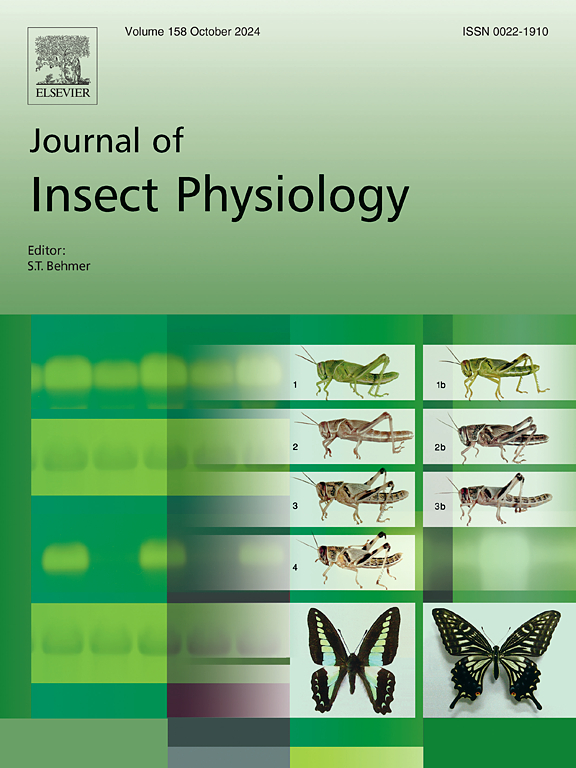Assessing nanoparticle-enabled dsRNA delivery for oral RNAi in two orthopteran pests: Schistocerca gregaria and Melanoplus sanguinipes
IF 2.3
2区 农林科学
Q1 ENTOMOLOGY
引用次数: 0
Abstract
Locusts and pest grasshoppers (Orthoptera: Acrididae) cause significant economic losses to agricultural crops and rangeland forage and can even cause humanitarian crises during periodic plagues. Current management methods for these insects rely heavily on broad-spectrum chemical insecticides and growth regulators, which can affect non-target organisms and may eventually develop resistance in the targeted species. Therefore, we assessed the potential of RNA interference (RNAi)-based alternative strategies that could supplement the current management methods. In insects, RNAi efficiency is known to vary with the method of double-stranded RNA (dsRNA) delivery. In this study, we tested two different delivery methods (injection and oral feeding) in the desert locust (Schistocerca gregaria) and the migratory grasshopper (Melanoplus sanguinipes) and showed that both species are sensitive to the injection but not to the oral feeding of dsRNA, likely due to high nuclease activity or poor uptake in the midgut. To address these limitations, we explored the utility of using nanoparticles that are often used for drug delivery in humans as a carrier (poly lactic-co-glycolic acid [PLGA] and poly(L-arginine)-polyethylene glycol [PLA-PEG]) for orally delivering dsRNA to the insect pests. Although the PLGA nanoparticles successfully permeated the digestive system into the hemolymph and the PLA-PEG-dsRNA complexes remained stable in the midgut juice and were detected in the fat body, neither dsRNA-encapsulating nanoparticle elicited gene knockdown upon oral feeding. These results suggest that nanoparticle-based oral delivery improves dsRNA stability and midgut permeation. However, additional barriers must be overcome to achieve efficient oral RNAi in these orthopteran pest species.

评估纳米颗粒使dsRNA在两种直足动物害虫中的口服RNAi递送:grestocerca gregaria和Melanoplus sanguinipes。
蝗虫和害虫蚱蜢(直翅目:蝗科)对农作物和牧场饲料造成重大经济损失,甚至在周期性瘟疫期间造成人道主义危机。目前对这些昆虫的管理方法严重依赖于广谱化学杀虫剂和生长调节剂,这些方法可以影响非目标生物,并可能最终在目标物种中产生抗药性。因此,我们评估了基于RNA干扰(RNAi)的替代策略的潜力,这些策略可以补充当前的管理方法。在昆虫中,已知RNAi效率随双链RNA (dsRNA)递送方法的不同而变化。在这项研究中,我们在沙漠蝗(Schistocerca gregaria)和迁徙蚱蜢(Melanoplus sanguinipes)中测试了两种不同的给药方法(注射和口服),结果表明这两种物种对注射dsRNA敏感,但对口服dsRNA不敏感,这可能是由于核酸酶活性高或在中肠吸收不良。为了解决这些限制,我们探索了使用通常用于人体药物递送的纳米颗粒作为载体(聚乳酸-羟基乙酸[PLGA]和聚(l -精氨酸)-聚乙二醇[PLA-PEG])的效用,用于向害虫口服dsRNA。尽管PLGA纳米颗粒成功地渗透到消化系统的血淋巴中,并且PLA-PEG-dsRNA复合物在中肠液中保持稳定,并且在脂肪体中检测到,但口服喂养时,dsrna包封纳米颗粒都不会引起基因敲低。这些结果表明,基于纳米颗粒的口服给药改善了dsRNA的稳定性和中肠渗透。然而,为了在这些骨科害虫物种中实现有效的口服RNAi,必须克服额外的障碍。
本文章由计算机程序翻译,如有差异,请以英文原文为准。
求助全文
约1分钟内获得全文
求助全文
来源期刊

Journal of insect physiology
生物-昆虫学
CiteScore
4.50
自引率
4.50%
发文量
77
审稿时长
57 days
期刊介绍:
All aspects of insect physiology are published in this journal which will also accept papers on the physiology of other arthropods, if the referees consider the work to be of general interest. The coverage includes endocrinology (in relation to moulting, reproduction and metabolism), pheromones, neurobiology (cellular, integrative and developmental), physiological pharmacology, nutrition (food selection, digestion and absorption), homeostasis, excretion, reproduction and behaviour. Papers covering functional genomics and molecular approaches to physiological problems will also be included. Communications on structure and applied entomology can be published if the subject matter has an explicit bearing on the physiology of arthropods. Review articles and novel method papers are also welcomed.
 求助内容:
求助内容: 应助结果提醒方式:
应助结果提醒方式:


